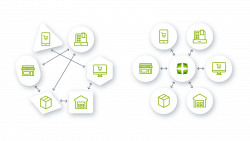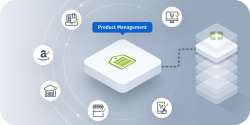Miniseries: A DOP for Omnichannel Product Management?
In the third part of this miniseries, we will talk about the DOP and Omnichannel Commerce product management.
First things first
Why should we talk about a DOP in relation to omnichannel commerce? Today’s social behavior is driving consumers to use multiple channels when researching or shopping for a product. Today’s customers expect their purchases to be convenient: they want control over when, how, and where they want to shop. While it is imperative that companies represent themselves across all sales channels, it should be ensured that all of these channels provide consumers with a consistent and complete experience with respect to the products they sell.
Organizations that accommodate omnichannel strategies thrive, did you know that:
- Businesses that have omnichannel strategies in place achieve 91% greater year-over-year customer retention compared to businesses that don’t.
- Companies with omnichannel customer engagement retain about 89% of their customers, compared to 33% for companies that don’t.
- Omnichannel customers have a 30% higher lifetime value than single-channel customers.
However:
- 55% of companies have no cross-channel strategy in place at all!
To cater to modern customer needs, businesses need to invest in their omnichannel strategy.
At the base of omnichannel selling is product availability in multiple channels. However, this might sounds simpler than it is! Omnichannel retailers experience many challenges when it comes to managing products in multiple channels.
In this third article of our miniseries, we will take a look at how to overcome these challenges and manage your products across multiple channels with a Digital Operations Platform.
What is Product Management?
Product management is at the heart of any commerce business. In this article, we refer to product management as:
- Product data: name, SKU, status, weight
- Variants and categories: color, size, product type
- Warranty
- Pricing: standard pricing, special pricing, currency
- TAX/VAT
- Sales channel availability

Omnichannel Product Management Challenges & Solutions
Despite the importance of product catalogs in successful retail and eCommerce operations, many retailers have found it difficult to manage effectively. There are a number of challenges retailers often face when trying to improve product management. Here are some of the challenges:
Product management is time-consuming and complex
Time is money, and retailers need to be able to source, standardize, and publish data as quickly as possible. However, managing products in multiple channels can be a challenge. Merchants without centralized data often find their product data dispersed across multiple systems that have been patched together. This makes working with product data time-consuming and complex.
The solution is to have a central platform in place that unifies product data. When different teams can work together on one platform, product data will always be available to anyone who wants to work with them. As all fields will be standardized, it will be as easy as filling in the right data and pushing it to the right sales channels. This will make managing product data much more efficient and cost-effective.
Managing product pricing in multiple channels
Modifying product pricing per the sales-channel specific format can be difficult. Pricing may differ between channels, as well as certain promotions and coupon codes. In a Digital Operations Platform, businesses are able to manage the pricing of products, per separate channel, in one single view. This means that it is no longer needed to switch between systems for different countries or currencies.

The same goes for TAX/VAT rates. In each country, different TAX/VAT rates may apply. This means that within certain sales channels, TAX/VAT rates need to be set for different product groups. Keeping track of the right rates can be hard, especially since they might change over time. Luckily it is easy to manage TAX/VAT in a DOP. All rates can be set in a central place, and then be connected to the right sales channels and products. This makes sure there can never be a mistake in which TAX/VAT rate needs to be calculated.
Dealing with legacy solutions
The above-mentioned challenges are even more pressing if merchants are using manual processes and/or legacy systems to manage product data. Often, legacy solutions (such as ERPs), cannot communicate. Custom integrations are often built between them, which are hard and expensive to maintain. Sometimes, manual actions have to be performed to transfer data between platforms, which gives way to errors in product data.
A DOP makes sure that product information from different platforms (such as a PIM) is gathered in one central place so it can be transferred to the right channels automatically. No unnecessary complex integrations, no more manual work, nothing to slow accurate omnichannel product management down.

Should you choose a DOP for omnichannel product management?
Yes. A DOP makes product management for multiple channels much easier. It allows your business to centralize product data and disperse it to your channels. Working with a DOP is more efficient, cheaper and makes sure fewer errors are made. As an added bonus, a DOP does much more than just product management. Take a look at the other blogs in this miniseries to find our more:
A DOP for Order Management
A DOP for Inventory Management
Back to blog
